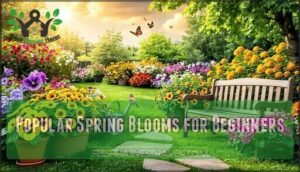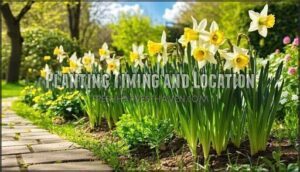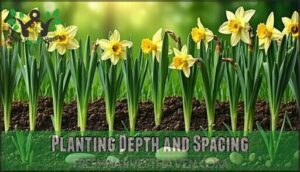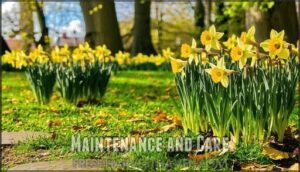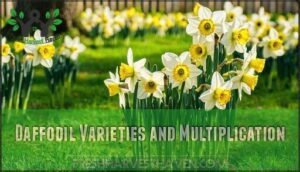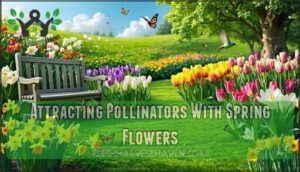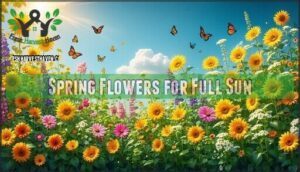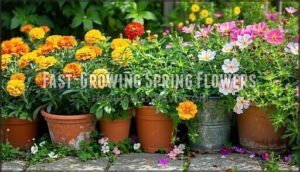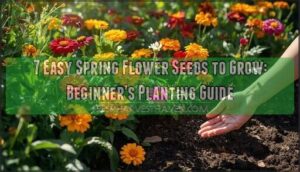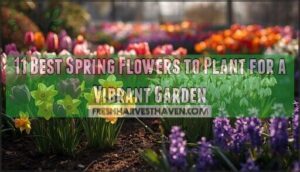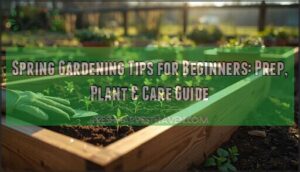This site is supported by our readers. We may earn a commission, at no cost to you, if you purchase through links.
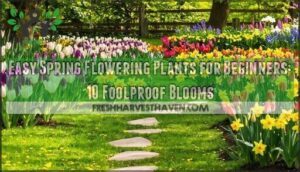
For quick results, try fast-growing annuals like marigolds and zinnias that handle temperature swings beautifully. Focus on well-drained soil with a pH between 6.0-7.0, and you’re set for success.
The secret isn’t having perfect conditions—it’s matching the right plants to your specific garden situation and climate zone for guaranteed blooms.
Table Of Contents
- Key Takeaways
- Choosing Easy Spring Flowers
- Popular Spring Blooms for Beginners
- Planting Daffodils and Care
- Attracting Pollinators With Spring Flowers
- Growing Spring Flowers in Different Conditions
- Frequently Asked Questions (FAQs)
- What is the easiest flower to grow in spring?
- What is the easiest flower to grow for beginners?
- What kind of flowers to plant in early spring?
- What is the first plant to flower in spring?
- What flower is best for beginners?
- Which spring flowers bloom the longest?
- What is the best low maintenance flowering plant?
- What is the first plant to bloom in spring?
- What is the easiest plant to grow in spring?
- What is the easiest flowering plant to grow?
- Conclusion
Key Takeaways
- You’ll succeed by choosing hardy, forgiving varieties like daffodils, crocuses, and marigolds that tolerate watering mistakes and adapt to various growing conditions without requiring perfect care.
- Match plants to your specific garden conditions rather than trying to create ideal environments—focus on your climate zone, soil drainage, and sunlight exposure to guarantee blooms.
- Start with reliable bulbs and fast-growing annuals that provide quick results and return annually, giving you confidence while you learn essential gardening skills through hands-on experience.
- Proper soil preparation with pH 6.0–7.0 and good drainage creates the foundation for success, but don’t overthink it—these beginner-friendly plants thrive in average conditions with minimal fuss.
Choosing Easy Spring Flowers
Before you start planting, you’ll need to take into account four key factors that determine success: your local climate zone, soil conditions, sunlight exposure, and available garden space.
Getting these basics right means you won’t waste time or money on flowers that won’t thrive in your specific conditions.
Climate and Weather Conditions
When selecting spring flowers, understanding your local climate zones becomes your gardening compass. Most easy spring bloomers thrive in daytime temperature fluctuations between 50-65°F, making hardiness zones 3-8 ideal for beginners. Weather patterns in your region dictate success more than soil quality. Late frosts can devastate tender shoots, while sudden heat waves shorten blooming periods. Full sun flowering plants like marigolds handle temperature swings better than delicate varieties.
Your local climate zone is your gardening compass—match your flowers to your weather patterns for guaranteed spring success
Rainfall management proves vital since spring flowers need 1-2 inches weekly. Excessive moisture without well-drained soil causes root rot, while drought stress stunts growth. Low maintenance varieties like daffodils tolerate weather extremes naturally.
Smart gardeners use frost protection methods like row covers during unpredictable spring weather:
- Monitor local frost dates to time plantings perfectly
- Choose drought-tolerant varieties for water-wise gardening
- Select cold-hardy options for unpredictable conditions
Your climate zone determines which full sun or shady spots work best for different varieties. Gardeners should consider sunny garden flowers when planning their spring blooms to help guarantee vibrant and thriving plants.
Soil Type and PH Level
Your garden’s soil composition determines everything. Most Easy Spring Flowering Plants need a pH balance between 6.0-7.0 for ideal nutrient levels. Clay soils require compost usage to improve drainage, while sandy types need organic matter for moisture retention. Test your soil first – it’s your foundation for success.
Well-drained soil with proper fertilizer types creates the perfect environment for low maintenance blooms that thrive in full sun conditions, making beginner gardening achievable. Understanding the soil pH levels is vital for maintaining a healthy garden ecosystem.
Sunlight Requirements
The right light conditions reveal your spring garden’s potential. Most easy spring flowering plants fall into three categories based on their sunlight needs.
Full Sun flowers need six or more hours of direct sunlight daily. These include marigolds, sunflowers, and zinnias that thrive in bright conditions. Morning Sun provides gentler rays compared to intense Afternoon Sun, which can stress delicate blooms.
Partial Shade lovers like pansies and impatiens prefer four to six hours of filtered light. Dappled Light under trees creates perfect conditions for these varieties.
Here’s what to keep in mind for Beginner Gardening success:
- Observe your yard’s light patterns throughout different times of day.
- Match Easy Spring Flowering Plants to their preferred light zones.
- Choose Low Maintenance varieties that tolerate light variations.
- Ensure Well-drained soil in sunny spots to prevent root problems.
- Start with forgiving flowers that adapt to various light conditions.
Track sunlight in your planting areas for a week. This simple step prevents disappointment and guarantees your spring blooms flourish in their ideal lighting conditions.
Available Space and Garden Layout
Small spaces don’t limit your Garden Size potential. Smart Layout Planning and Space Optimization create stunning displays anywhere through strategic design choices.
Consider these Compact Blooms solutions for maximum impact:
- Vertical Gardening with trellises supporting climbing nasturtiums in Full Sun locations
- Container arrangements on patios featuring Low Maintenance Gardening favorites like pansies
- Shady Spot Gardening with Well-drained beds along walkways using cosmos
Beginner Gardening succeeds through clever planning, not square footage.
Popular Spring Blooms for Beginners
Now that you’ve identified your ideal growing conditions, certain Spring Flowers stand out as particularly Beginner Friendly Flowers that practically guarantee success. Beginner Gardeners can’t go wrong with these proven performers for Low Maintenance Gardening:
Spring Florals
These Easy Spring Flowering Plants offer staggered Bloom Timing, ensuring your Garden Designs stay colorful from March through June. Pansies bloom within 45 days, while marigolds reach flowering stage in 50-60 days with minimal fuss. Daffodils lead with their cheerful yellow faces, followed by cosmos and petunias that keep blooming strong. Each variety forgives common mistakes like irregular watering or forgotten deadheading. You’ll discover that successful Beginner Gardening starts with choosing plants that want to thrive, making your Flower Arrangements both beautiful and stress-free. For ideal growth, understanding soil preparation tips is essential to create a thriving garden environment.
Planting Daffodils and Care
Daffodils are the perfect starter flower because they’re practically foolproof and return year after year with minimal effort. You’ll plant bulbs once in fall and enjoy reliable spring blooms for decades with basic care.
Planting Timing and Location
Mastering Climate Zones transforms your spring gardening success from guesswork into guaranteed results. Plant daffodil bulbs during late fall—October through November for most regions—allowing 6-8 weeks before hard frost arrives. Southern gardeners can extend Blooming Schedules by planting through December.
Garden Mapping your yard reveals perfect locations where Easy Spring Flowering Plants thrive. Scout spots receiving Full Sun during morning hours while avoiding afternoon scorchers. Sunlight Analysis shows daffodils need 4-6 hours daily light for healthy blooms. Skip low areas where water pools—Welldrained soil prevents bulb rot. Poor drainage? Container gardening offers freedom from soggy conditions.
Soil Preparation before planting creates the foundation for Beginner Friendly Flowers that’ll make neighbors jealous. These Spring Gardening Tips guarantee your daffodils survive winter’s grip and emerge triumphantly when warm weather returns, delivering that liberation from brown winter landscapes you’ve been craving. For ideal growth, consider purchasing high-quality daffodil bulbs to plant in your garden.
Planting Depth and Spacing
Getting your daffodil planting depth and spacing right sets you free from future garden headaches. These Easy Spring Flowering Plants thrive when you follow simple soil preparation rules.
Plant each bulb at three times its height—a 2-inch bulb needs a 6-inch deep hole. Space bulbs 4-6 inches apart to prevent root competition. This garden layout gives each bulb room to establish strong foundations without fighting neighbors for nutrients.
Picture these Planting Techniques creating underground success:
- Deep roots: Proper depth anchors bulbs against wind and frost heave
- Breathing room: Adequate seed spacing prevents fungal diseases from spreading between crowded bulbs
- Natural multiplication: Spaced bulbs produce more daughter bulbs over time
Understanding the correct planting depth guidelines is essential for the health and growth of your spring blooms.
Your bed arrangement becomes a Low Maintenance Plants paradise when you get spacing right from day one. These Spring Gardening Tips transform your Easy to Grow Flowers into reliable performers. Proper spacing means less work later—no dividing overcrowded clumps or dealing with stunted blooms.
Maintenance and Care
Daffodils thrive with minimal care once established. These easy to care flowers rarely need extra fertilizer types beyond annual compost applications. Low maintenance garden maintenance means less work, more blooms. Flower care stays simple with these hardy spring favorites.
Use watering techniques that provide deep, weekly soaks rather than daily sprinkles. Mulching benefits include moisture retention and weed suppression around bulbs. Soil conditioning with organic matter enhances healthy growth.
Skip complex pruning methods – simply remove spent blooms.
Daffodil Varieties and Multiplication
Over 32,000 daffodil hybrids exist worldwide, giving you endless choices for spring flower gardening. These easy-to-grow flowers multiply through natural bulb division, creating lasting displays with minimal effort.
Top varieties for gardening for beginners:
- King Alfred – classic yellow trumpet
- Carlton – reliable large-cup variety
- Tête-à-Tête – miniature charmer
- Ice Follies – white petals, yellow cup
- Minnow – compact jonquilla type
Flower propagation happens automatically as bulbs triple over three years.
Attracting Pollinators With Spring Flowers
You’ll create a thriving pollinator paradise by choosing spring flowers that provide essential nectar and pollen sources for local wildlife. The right plant selection transforms your beginner garden into a buzzing ecosystem that nurtures bees, butterflies, and hummingbirds throughout the growing season.
Flowers for Bees and Butterflies
Success arrives when you create pollinator gardens that welcome spring’s busiest visitors. Crocus provides March’s earliest nectar sources for emerging bees, while grape hyacinth attracts both bumblebees and solitary species with four-week blooms. Plant lungwort for high-nectar value that aids early butterflies like brimstones. Blue, purple, and white flowers—including alliums and scilla—attract bees most effectively. Single-flowered varieties outperform doubles for nectar access. Mass plantings of bee-friendly species increase visibility for foraging insects. Native bluebells see 80% of visits from long-tongued bumblebees. These easy-to-grow flowers create beautiful flower beds in full sun while promoting floral diversity.
Flower Best For Bloom Period
Choose pesticide-free, pollinator-friendly plants for the healthiest results.
Flowers for Hummingbirds
Anyone can attract hummingbirds with the right nectar-rich flowers. These tiny birds prefer tubular flowers in vibrant colors that provide easy access to sweet rewards.
Here are three hummingbird feeders’ perfect companions:
- Fuchsias – Drooping trumpet blooms offer abundant nectar in shaded spots
- Salvias – Heat-tolerant spikes thrive in full sun with continuous spring blooms
- Petunias – Low-maintenance beauties create stunning pollinator gardens alongside feeders
These pollinator-friendly plants transform any space into hummingbird heaven with minimal effort required.
Supporting Local Ecosystems
Your garden becomes a thriving wildlife sanctuary when you choose Native Plant Species over exotic imports. Pollinator Gardens featuring local bloomers like wild columbine support up to 10 times more wildlife than non-native alternatives.
These Pollinator Friendly Plants create Ecosystem Services that strengthen food webs and boost insect diversity by 25%. Native Plants require minimal water and fertilizer, making Sustainable Landscaping straightforward.
Full Sun natives and LowMaintenance varieties establish Biodiversity Conservation corridors that connect fragmented habitats. Your EasytoGrow Flowers aren’t just pretty—they’re ecological powerhouses supporting local ecosystems.
Growing Spring Flowers in Different Conditions
Your garden conditions don’t have to limit your spring flower choices when you select the right plants for each spot. Whether you’re working with blazing sun, deep shade, or something in between, there’s a foolproof bloom that’ll thrive in your specific growing environment.
Spring Flowers for Full Sun
While pollinators love variety, your sunniest spots deserve flowers that won’t wilt under pressure. Full sun areas receive six or more hours of direct sunlight daily, creating perfect conditions for heat-tolerant flowers that deliver stunning blooms.
These easy-to-grow flowers handle blazing conditions while providing continuous color throughout blooming times. They’re naturally drought-resistant once established, making them perfect low-maintenance choices for busy gardeners.
Top Full Sun Perennials and Spring Flowers:
- Sunflowers – Towering giants requiring minimal sunflower care beyond occasional watering
- Marigolds – Pest-repelling workhorses that bloom non-stop in heat
- Zinnias – Vibrant pollinator-friendly plants perfect for cutting gardens
- Cosmos – Delicate-looking but tough performers in scorching conditions
- Black-eyed Susans – Hardy perennials that return yearly with golden blooms
These varieties thrive where others struggle, transforming your brightest spaces into stunning displays. For ideal growth, consider full sun flowers that are specifically suited to your local climate and soil conditions.
Spring Flowers for Shady Spots
While full sun gardens grab attention, shade tolerant areas offer their own charm. Partial shade locations support low light flowers like impatiens, begonias, and coleus beautifully. These shady blooms require minimal care while creating stunning woodland gardens.
Plant caladiums for bold foliage or torenia for delicate purple flowers. Your beautiful garden doesn’t need constant sunshine—these spring flowers thrive in dappled light, making flower garden tips simple. Even your spring garden‘s shadiest corners can burst with color.
Fast-Growing Spring Flowers
In the context of instant satisfaction, fast-growing spring flowers deliver results that’ll make your neighbors green with envy. These speed demons transform from flower seeds to stunning spring blooms in record time.
Marigolds germinate within 5-7 days and bloom in just 45-60 days with minimal care. Zinnias race to first flowers in 50 days, thriving in full sun conditions. Cosmos sprout in 7 days and flower within 7-10 weeks.
These growing flowers offer beginner-friendly gardening tips for quick success:
- Nasturtiums produce blooms in just 35-50 days
- Sweet alyssum reaches peak color by late spring
- California poppies flower within 6-8 weeks
Proper bloom times and basic flower care guarantee these easy flowers provide reliable spring color with minimal fuss.
Annuals and Perennials for Beginners
While fast-growing flowers give quick results, understanding Annuals versus Perennials helps with smart Flower Selection and Garden Planning. Annuals complete their lifecycle in one season but reward you with extended Bloom Timing, while Perennials return yearly with Minimal Care after establishment.
Your Beginner Gardening Tips start with Soil Preparation—test pH levels between 6.0-7.0 and add compost for drainage. Easy Flowers like marigolds (annual) bloom within 50 days, while daffodils (perennial) offer 95% success rates when planted properly. Understanding soil requirements is essential for the health and longevity of your plants.
| Feature | Annuals | Perennials |
|---|---|---|
| Lifespan | One growing season | Multiple years |
| Cost | Lower initial, higher yearly | Higher initial, lower long-term |
| Maintenance | Replant annually | Minimal after establishment |
| Bloom Duration | Extended flowering period | Shorter, specific seasons |
| Examples | Marigolds, zinnias, petunias | Daffodils, coneflowers, sedum |
These Beginner Tips create freedom from complicated gardening while building confidence through reliable blooms.
Frequently Asked Questions (FAQs)
What is the easiest flower to grow in spring?
Marigolds make superb spring starters for novice gardeners. You’ll find these hardy annuals require minimal care while delivering maximum color. They’re drought-tolerant, pest-resistant, and bloom reliably in most conditions.
What is the easiest flower to grow for beginners?
Daffodils are your best bet for foolproof gardening success. These hardy bulbs tolerate neglect, bloom reliably each spring, and multiply naturally.
Plant them once in fall, then enjoy years of cheerful yellow blooms without fuss.
What kind of flowers to plant in early spring?
Plant cold-hardy annuals like pansies, calendula, and sweet alyssum in early spring. These resilient flowers tolerate cool temperatures and light frosts while establishing strong root systems before summer heat arrives.
What is the first plant to flower in spring?
Like a whispered promise of renewal, the crocus appears as a classic herald of spring. **You’ll spot these hardy bulbs breaking through frozen soil in late winter.
** These early blooming flowers, known as spring ephemerals, emerge before trees leaf out.
Their vibrant purple, white, and yellow petals signal winter’s end. **For a beautiful display, consider planting early spring flowers in your garden.
What flower is best for beginners?
You’ll find tulips are your best bet. They’re hardy, need little fuss, and bloom reliably.
Just tuck bulbs into well-drained soil, give them sunlight, and watch your garden burst with color—no green thumb required.
Which spring flowers bloom the longest?
Perennials are your garden’s marathon runners, delivering consistent blooms while annuals sprint through single seasons. You’ll get extended flowering from pansies, which tolerate cool weather and bloom for months. Marigolds also provide continuous color from spring through frost with regular deadheading.
What is the best low maintenance flowering plant?
Daffodils offer you the supreme low-maintenance experience. You’ll plant bulbs once in fall, then enjoy years of reliable spring blooms without fussing over watering, fertilizing, or deadheading requirements.
What is the first plant to bloom in spring?
Crocuses usually emerge as spring’s earliest bloomers, often pushing through snow in late February or March. These hardy bulbs signal winter’s end with their cheerful purple, white, and yellow flowers before most other plants wake up.
What is the easiest plant to grow in spring?
Like spring’s gentle awakening, marigolds offer you the sweetest gardening victory. These hardy annuals forgive beginner mistakes, bloom reliably in poor soil, and don’t mind irregular watering schedules.
What is the easiest flowering plant to grow?
Marigolds are your best bet for foolproof spring blooms. You’ll plant seeds directly in garden soil, water weekly, and watch them flourish in just fifty to sixty days with virtually zero fuss required.
Conclusion
Starting your garden with easy spring flowering plants for beginners is like having a reliable friend who shows up when promised. You’ve discovered that success comes from matching hardy varieties to your specific conditions rather than creating perfect environments.
Focus on proven performers like daffodils, crocuses, and marigolds that forgive mistakes while delivering consistent blooms. These resilient plants establish the foundation for gardening confidence, teaching you essential skills through hands-on experience. **Your spring garden awaits.
**
- https://planthardiness.ars.usda.gov/
- https://www.fantasticgardeners.co.uk/window-boxes/what-is-the-best-soil-to-use-for-planting-flowers/
- https://www.horiba.com/int/water-quality/applications/agriculture-crop-science/soil-ph-and-nutrient-availability/
- https://fieldreport.caes.uga.edu/news/hydrangea-blooms-turn-colors-based-on-soil-ph-levels/
- https://www.bloomandsong.com/hong-kong-wedding-flowers/guide-to-the-best-soil-types-for-different-types-of-flowers

